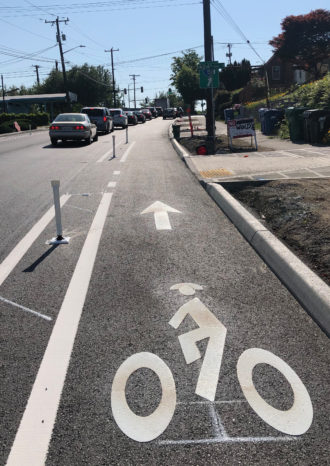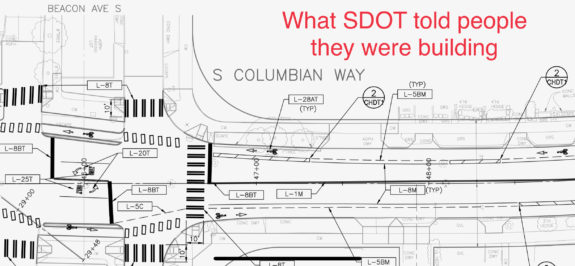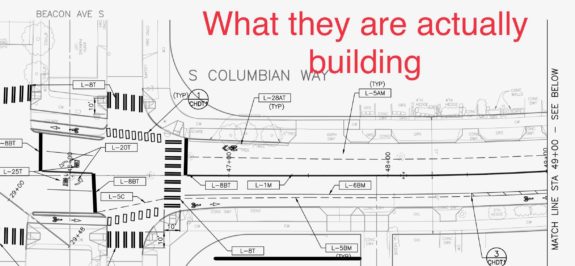SDOT quietly deletes key section from southend bike lane at the last minute, misleads the public about the change

Photo taken May 31 shows that the bike lane ends before the intersection.
In yet another hit to the already sorely lacking southend bike network, SDOT quietly made a last-minute change to the Columbian Way paving project to remove an uphill section of protected bike lane as the road approaches Beacon Ave S. Neighbors didn't know about the change until crews painting the planned bike lanes on the repaved street ended them half a block east of Beacon Ave S.
Just how quiet was this change? Even the project's own communications and outreach staff didn't seem to know about it as recently as June 6, according to emails sent to reader Matthew Snyder. Snyder had contacted the team May 29 as soon as he and other neighbors noticed the gap in the bike lane. A week later, SDOT staff sent this reply:
"We understand your concerns since striping is not yet completed. Crews are planning to complete striping on S Columbian Way / S Alaska St soon. Please see the attached PDF of the PBL plan where it shows that the PBL on S Columbian Way will continue through the intersection with Beacon Ave S. The plan also follows the City of Seattle's protected bike lane intersection design standards. We hope that helps answer your questions."
The document they sent was the 95% construction plan, which includes the complete bike lane neighbors thought was being constructed (the top image on this post). But the project engineers made a last-minute change to replace a block of the bike lane with sharrows, and they did so without any kind of public outreach or even public notice. They didn't even bother to tell their own outreach staff or make sure information on the project website was updated to reflect the change.
Snyder, being a tenacious and engaged neighbor, was able to track down the 100% plans from the city's contractor bidding website (the second image above). The team finally acknowledged in an email dated June 12 that the bike lane would "become a sharrow to make room for a right turn lane and traffic lane."
This bike lane is among the only significant stretches of protected bike lanes SDOT currently plans in all of Southeast Seattle for the entirety of the Move Seattle Levy, despite consistent advocacy from all major advocacy organizations and the city's own Bicycle Advisory Board urging the city to correct past injustices and invest heavily in the southend. And this gap greatly diminishes the effectiveness of this vital bike route. A bike route is only as comfortable as its least comfortable section. A missing gap like this is likely the difference between whether a family will use the lane with their kids or not, for example. This is the route from Columbia City to Jefferson Park and Mercer Middle School, for example. So eleven-year-olds are now supposed to just merge with car traffic every day while biking up a major hill to school?
Not only is the sabotaging of this bike lane extremely concerning, but the complete lack of public notice raises a lot of troubling questions. Compare the years of public outreach neighbors in wealthier, whiter Wedgwood received for planned bike lanes on 35th Ave NE as part of that repaving project to the complete disregard Columbia City and Beacon Hill neighbors received when SDOT decided to delete a key section of bike lane from this paving project. If there were arguments for removing this section of bike lane, people never had the opportunity to discuss them or advocate for a complete bike connection.
Mayor Jenny Durkan had contractors change the paving plan for 35th Ave NE after construction had already started to completely remove the planned bike lanes there. So we know she can add the bike lane back here. These sharrows are not good enough, and they do not meet the goals of the Bicycle Master Plan.
But this scandal also raises serious questions about SDOT's trustworthiness. The public was clearly misled. The question is whether SDOT was lying or inept, neither of which is good. The department is investing public money into these projects, and the public has a right to know what they are building and when they make major changes to the core functionality of planned projects. And people in southeast Seattle have just as much right to know as people in northeast Seattle.

